

Polemonium, titular see in Pontus Polemoniacus, suffragan of Neocaesarea. At the mouth of the Sidenus, on the coast of Pontus in the region called Sidene, was a town called Side, which, it is believed, took the name of Polemonium in honor of Polemion, made King of Pontus by Marcus Antonius about 36 B.C. Doubtless its harbor gave it a certain importance, since it gave its name to the Pontus Polemoniacus. It is now the village of Pouleman in the vilayet of Trebizond, on the right bank of the Pouleman Tchai; the ruins of the ancient town, octagonal church, and ram-parts, are on the left bank. Six of its bishops are known: Aretius, present at the Council of Neocaesarea in 320 (he was perhaps Bishop of Lagania); John, at Chalcedon (451), signer of the letter from the bishops of the province to Emperor Leo (458); Anastasius, at the Council of Constantinople (680); Domitius, at the Council of Constantinople (692); Constantine, at Nica (787); John, at Constantinople (869 and 879). The “Notitiae episcopatuum” mentions the see until the thirteenth century.
S. PETRIDES

